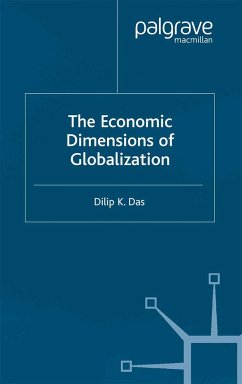D. Das
The Economic Dimensions of Globalization
D. Das
The Economic Dimensions of Globalization
- Broschiertes Buch
- Merkliste
- Auf die Merkliste
- Bewerten Bewerten
- Teilen
- Produkt teilen
- Produkterinnerung
- Produkterinnerung
Dilip K. Das succintly covers the principal normative and positive strands that one needs to be properly familiar with in the area of economic globalization. The selection and rejection of themes for coverage in the book has been carefully done. The picture of globalization has been painted with a broad brush. The unique feature that distinguishes it from the competition is its succinct coverage of numerous, carefully selected, thematic issues that falls under the rubric of globalization. The book is easy to access for the target readership because of its descriptive analysis style.
Andere Kunden interessierten sich auch für
![The Economic Dimensions of Globalization The Economic Dimensions of Globalization]() D. DasThe Economic Dimensions of Globalization122,99 €
D. DasThe Economic Dimensions of Globalization122,99 €![Globalization and the Welfare State Globalization and the Welfare State]() Bo SöderstenGlobalization and the Welfare State77,99 €
Bo SöderstenGlobalization and the Welfare State77,99 €![Globalization and the Welfare State Globalization and the Welfare State]() Bo SöderstenGlobalization and the Welfare State121,99 €
Bo SöderstenGlobalization and the Welfare State121,99 €![Economic Transformation, Democratization and Integration Into the European Union Economic Transformation, Democratization and Integration Into the European Union]() Economic Transformation, Democratization and Integration Into the European Union39,99 €
Economic Transformation, Democratization and Integration Into the European Union39,99 €![The Arab Spring in the Global Political Economy The Arab Spring in the Global Political Economy]() Leila S. TalaniThe Arab Spring in the Global Political Economy39,99 €
Leila S. TalaniThe Arab Spring in the Global Political Economy39,99 €![Globalization in the Twenty-First Century Globalization in the Twenty-First Century]() A. HülsemeyerGlobalization in the Twenty-First Century39,99 €
A. HülsemeyerGlobalization in the Twenty-First Century39,99 €![The Arab Spring in the Global Political Economy The Arab Spring in the Global Political Economy]() Leila S. TalaniThe Arab Spring in the Global Political Economy39,99 €
Leila S. TalaniThe Arab Spring in the Global Political Economy39,99 €-
-
-
Dilip K. Das succintly covers the principal normative and positive strands that one needs to be properly familiar with in the area of economic globalization. The selection and rejection of themes for coverage in the book has been carefully done. The picture of globalization has been painted with a broad brush. The unique feature that distinguishes it from the competition is its succinct coverage of numerous, carefully selected, thematic issues that falls under the rubric of globalization. The book is easy to access for the target readership because of its descriptive analysis style.
Produktdetails
- Produktdetails
- Verlag: Palgrave Macmillan / Palgrave Macmillan UK / Springer Palgrave Macmillan
- Artikelnr. des Verlages: 978-1-349-51433-5
- Softcover reprint of the original 1st ed. 2004
- Seitenzahl: 214
- Erscheinungstermin: 1. Januar 2004
- Englisch
- Abmessung: 203mm x 133mm x 12mm
- Gewicht: 266g
- ISBN-13: 9781349514335
- ISBN-10: 1349514330
- Artikelnr.: 45082578
- Herstellerkennzeichnung
- Libri GmbH
- Europaallee 1
- 36244 Bad Hersfeld
- gpsr@libri.de
- Verlag: Palgrave Macmillan / Palgrave Macmillan UK / Springer Palgrave Macmillan
- Artikelnr. des Verlages: 978-1-349-51433-5
- Softcover reprint of the original 1st ed. 2004
- Seitenzahl: 214
- Erscheinungstermin: 1. Januar 2004
- Englisch
- Abmessung: 203mm x 133mm x 12mm
- Gewicht: 266g
- ISBN-13: 9781349514335
- ISBN-10: 1349514330
- Artikelnr.: 45082578
- Herstellerkennzeichnung
- Libri GmbH
- Europaallee 1
- 36244 Bad Hersfeld
- gpsr@libri.de
DILIP K. DAS was educated at the Graduate Institute of International Studies, University of Geneva, Switzerland. A former professor of international economics, international trade and international finance, he was associated with Webster College Geneva; ESSEC, Paris; INSEAD, Fontainebleau, France; Australian National University; Graduate School of Business, University of Sydney. He has published extensively on international trade, international finance and globalization related issues.
Preface GLOBALIZATION: INTRODUCING THE CONCEPT Globalization: Vintage Twenty-First Century Definition Taxonomy of Globalization Benevolent Debate Versus Malevolent Debate Non-globalizing Economics Globalization and the Catch-up Endeavors in Transition Economies Globalization: Mercurial and Un-global Globalization and Poverty Can Globalization Hurt the Poor? Globalization and the Incidence of Poverty Globalization and the Quality of Life Globalization and Poverty Alleviation: A Non-linear Relationship Globalization and Income Inequality: The Case of China Conclusions and Summing-up GLOBALIZATION: TRACING THE PROGRESS Changing Gears of Globalization Global Economic Integration in the Second Millennium First Modern Era of Globalization Dismantling Globalization Return to Globalization Contemporary Era of Globalization Contemporary Globalization and Capital Flows Conclusions and Summing-up ECONOMIC DIMENSIONS OF GLOBALIZATIONS Globalization and Exchange Rate Regimes Options for Currency Regimes Mitigating Currency Crises Globalization and Monetary Policy Globalization and Fiscal Revenue Globalization and Competition Globalization and the Labor Markets Globalization and Migration Flows Globalization and Flight of Human Capital Globalization and Income Convergence Conclusions and Summing-up TRADE AND GLOBAL INTEGRATION Evolving Global Trading System Trade Policy Liberalization and Globalization Facets of Trade Liberalization Multilateral Trade Negotiations under GATT and WTO Regimes Declining Distortions and Enhancing Market Access Changing Trade Patterns and Growing Integration Trade and Globalization Empirical Evidence of Globalization in Trade Empirical Evidence of Globalization in Goods Markets Regional Differences in Trade Integration Conclusions and Summing-up FINANCIAL FLOWS AND GLOBAL INTEGRATION Novelty of Financial Globalization Agents of Financial Globalization Financial Globalization in the Nineteenth and Early Twentieth Centuries Financial Globalization: TheDestructive Phase Emerging Financial Architecture after the Second World War Financial Globalization after the Bretton Woods Failure Financial Globalization and Efficiency Financial Globalization and Growth Nexus Financial Globalization and the Domestic Financial Sector Dimensions of Net Capital Flows to Emerging Market Economies Globalizing Financial Services Conclusions and Summing-up GLOBAL FINANCIAL ARCHITECTURE AND FINANCIAL AND REGULATORY INFRASTRUCTURE Global Financial Architecture Radical Transformation Prevailing Status Areas of Immediate Reform The Bretton Woods Twins: A Privileged Position International Codes of Conduct Autonomy of Capital Account Standstill Provision Bailing-in the Private Sector Antidote for Financial and Macroeconomic Instability The New Basle Accord Exchange Rate Policies and Financial Globalization Conclusions and Summing-up Bibliography
Preface GLOBALIZATION: INTRODUCING THE CONCEPT Globalization: Vintage Twenty-First Century Definition Taxonomy of Globalization Benevolent Debate Versus Malevolent Debate Non-globalizing Economics Globalization and the Catch-up Endeavors in Transition Economies Globalization: Mercurial and Un-global Globalization and Poverty Can Globalization Hurt the Poor? Globalization and the Incidence of Poverty Globalization and the Quality of Life Globalization and Poverty Alleviation: A Non-linear Relationship Globalization and Income Inequality: The Case of China Conclusions and Summing-up GLOBALIZATION: TRACING THE PROGRESS Changing Gears of Globalization Global Economic Integration in the Second Millennium First Modern Era of Globalization Dismantling Globalization Return to Globalization Contemporary Era of Globalization Contemporary Globalization and Capital Flows Conclusions and Summing-up ECONOMIC DIMENSIONS OF GLOBALIZATIONS Globalization and Exchange Rate Regimes Options for Currency Regimes Mitigating Currency Crises Globalization and Monetary Policy Globalization and Fiscal Revenue Globalization and Competition Globalization and the Labor Markets Globalization and Migration Flows Globalization and Flight of Human Capital Globalization and Income Convergence Conclusions and Summing-up TRADE AND GLOBAL INTEGRATION Evolving Global Trading System Trade Policy Liberalization and Globalization Facets of Trade Liberalization Multilateral Trade Negotiations under GATT and WTO Regimes Declining Distortions and Enhancing Market Access Changing Trade Patterns and Growing Integration Trade and Globalization Empirical Evidence of Globalization in Trade Empirical Evidence of Globalization in Goods Markets Regional Differences in Trade Integration Conclusions and Summing-up FINANCIAL FLOWS AND GLOBAL INTEGRATION Novelty of Financial Globalization Agents of Financial Globalization Financial Globalization in the Nineteenth and Early Twentieth Centuries Financial Globalization: TheDestructive Phase Emerging Financial Architecture after the Second World War Financial Globalization after the Bretton Woods Failure Financial Globalization and Efficiency Financial Globalization and Growth Nexus Financial Globalization and the Domestic Financial Sector Dimensions of Net Capital Flows to Emerging Market Economies Globalizing Financial Services Conclusions and Summing-up GLOBAL FINANCIAL ARCHITECTURE AND FINANCIAL AND REGULATORY INFRASTRUCTURE Global Financial Architecture Radical Transformation Prevailing Status Areas of Immediate Reform The Bretton Woods Twins: A Privileged Position International Codes of Conduct Autonomy of Capital Account Standstill Provision Bailing-in the Private Sector Antidote for Financial and Macroeconomic Instability The New Basle Accord Exchange Rate Policies and Financial Globalization Conclusions and Summing-up Bibliography








